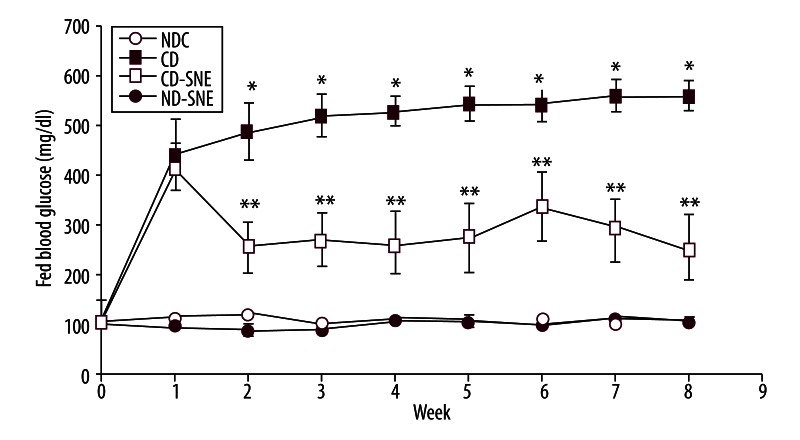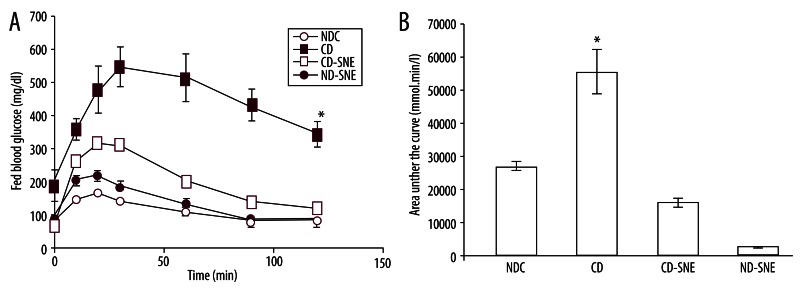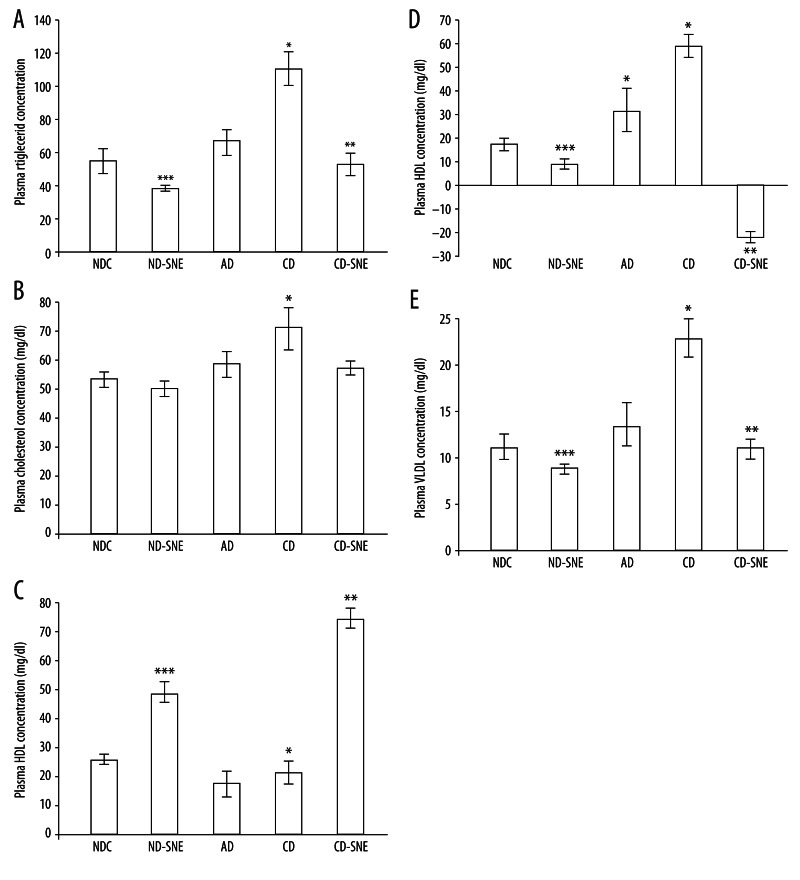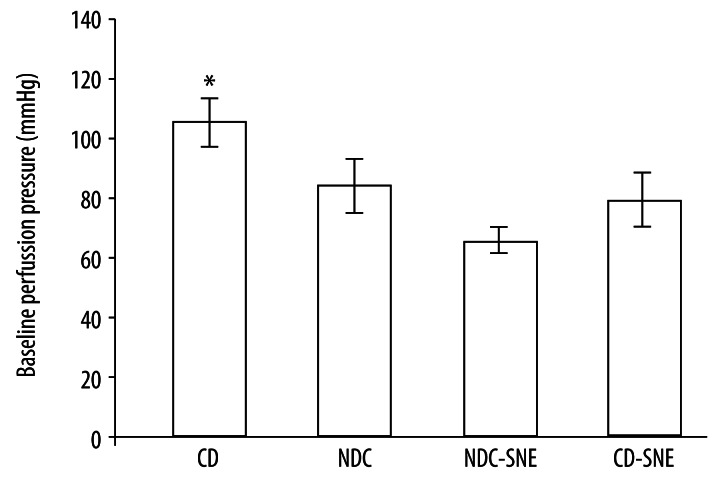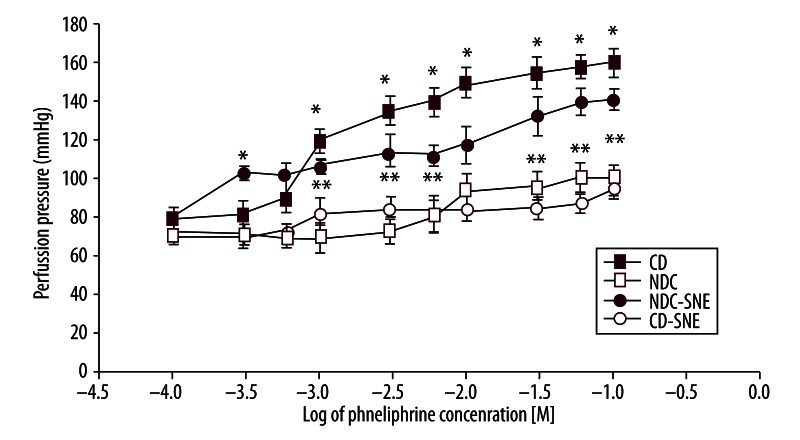Abstract
Background
Solanum nigrum fruit is traditionally used in Asia to manage, control, and treat diabetes but there is no scientific evidence of the efficacy of Solanum nigrum fruit in treatment of diabetes. We designed this study to investigate the effect of the administration of oral doses of aqueous extract from Solanum nigrum fruit on plasma glucose, lipid profiles, and the sensitivity of the vascular mesenteric bed to Phenylephrine in diabetic and non-diabetic rats.
Material/Methods
Animals were divided into 5 groups (n=10): 2 groups served as non-diabetic controls (NDC), and the other groups had diabetes induced with a single injection of streptozotocin (STZ). Solanum nigrum-treated chronic diabetic (CD-SNE) and Solanum nigrum-treated controls (ND-SNE) received 1g/l of Solanum nigrum added to drinking water for 8 weeks. The mesenteric vascular beds were prepared using the McGregor method.
Results
Administration of Solanum nigrum caused Ca/Mg ratio, plasma glucose, high-density lipoprotein (HDL), low-density lipoprotein (LDL), very low-density lipoprotein (VLDL), total cholesterol, and triglyceride concentrations to return to normal levels, and was shown to decrease alteration in vascular reactivity to vasoconstrictor agents.
Conclusions
Our results support the hypothesis that Solanum nigrum could play a role in the management of diabetes and the prevention of vascular complications in STZ-induced diabetic rats.
Keywords: diabetes, lipid profile, Solanum nigrum, blood glucose, mesenteric bed, Ca/Mg ratio
Background
Diabetes mellitus is a metabolic disorder characterized by hyperglycemia and alterations in carbohydrate, fat, and protein metabolisms associated with absolute or relative deficiencies in insulin secretion and/or insulin action [1]. Hyperglycemia has a direct, harmful effect on the cardiovascular system, and requires, at the very least, a link between acute hyperglycemia and 1 or more risk factors for cardiovascular disease (CVD) [2]. Associated with obesity, there is hyperinsulinemia, high circulating triglyceride and low HDL, and alteration in the sensitivity or reactivity of vascular smooth muscle to neurotransmitters and circulating hormones, which may cause or contribute to diabetic vessel complications [3,4]. In diabetes, the plasma cholesterol level is usually elevated and this plays a role in the accelerated development of atherosclerotic vascular disease, which is a major long-term complication of diabetes in humans [5].
The search for appropriate hypoglycemic agents has recently focused on plants, and many herbal medicines have been recommended for the treatment of diabetes [6]. Herbal drugs are frequently considered to be less toxic than their synthetic counterparts and they have fewer adverse effects [7].
Solanum nigrum, belonging to the Solanaceae family, is a weed of wastelands, old fields, and ditches. It is an annual branched herb up to 90 cm high, with dull dark green leaves. Its flowers are small and white, with a short pedicellate and 5 widely spread petals, found in most parts of Iran, India, and Southern Europe. Some of the beneficial uses of Solanum nigrum extract include, its action against microbial infections, cure of skin diseases and as a hypoglycemic and anti-ulcerogenic agent [8]. The plant is cultivated as a food crop, both for its fruit and its leaves, in some parts of the world and it appears that its toxicity can vary considerably according to where the plant is grown and the cultivar that is being grown [9].
The leaves, stems, and roots are used externally as a poultice in the treatment of cancerous sores, boils, leucoderma, and wounds. Extracts of the plant are analgesic, antispasmodic, anti-inflammatory and vasodilator [9]. The plant has been used in the manufacture of locally analgesic ointments and the juice of the fruit has been used as an analgesic for toothaches [9]. Poongothai et al. [9] also showed that administration of Solanum nigrum leaves to alloxan-induced diabetic rats caused significant anti-hyperglycemic and hypolipidemic effects. Some studies have shown that oral administration of ethanolic extract of Solanum nigrum on blood sugar of albino rat for 5 and 7 days leads to significant decrease in blood sugar compared to controls [10]. Recent studies have revealed that administration of Solanum nigrum leaves in normoglycemic and diabetic rats could decrease blood glucose level via increase in insulin secretion [11,12]. Maharana et al. [12] have provided evidence to support the hypolipidemic effect of extract of Solanum nigrum leaves. Previous reports indicated that Solanum nigrum fruits and leaves possess beneficial activity as an anti-ulcer, antioxidant and anti-tumor agent in rats [13,14]. More recent reports showed that the plant has been used in the traditional Indian medicinal system to treat inflammation, edema, and mastitis [13]. In Iran, Solanum nigrum fruit is traditionally used to manage, control, and treat diabetes. However, little is known about the therapeutic action, mechanism, or safety of these treatments in diabetic and healthy individuals. Based on these reports, we designed this study to investigate the effect of oral Solanum nigrum fruit administration on plasma glucose, triglycerides, LDL, HDL, VLDL, total cholesterol levels, and sensitivity of the vascular mesenteric bed to Phenylephrine in normal and diabetic rats.
Material and Methods
Animals
The animals were handled in accordance with the criteria outlined in NIH publication #85-23, revised in 1985, and our animal ethics permission was HEC 89-11-5. Male Wistar rats, weighing 180–250 g, were selected and housed at a constant temperature of 22±2°C with a fixed 12:12-h light-dark cycle. Nutritionally balanced pellets and water were freely available. The animals were divided into 5 groups (10 rats in each group): non-diabetic control (NDC); acute diabetic (AD); chronic diabetic (CD); Solanum nigrum-treated chronic diabetic (CD-SNE), and Solanum nigrum extract-treated control (ND-SNE).
Diabetes was induced with IP injection of 60 mg/kg STZ. At 10 days after diabetes induction, fasting blood glucose level was measured with an Ascensia ELITE XL glucometer and Ascensia Elite blood glucose test strips. Rats with blood glucose levels above 250 mg/dl were included in the study. Animals in which diabetes lasted for no longer than10 days were classed as ‘acute diabetic’ and those in which the diabetes lasted for 8 weeks or longer were defined as ‘chronic diabetic’. The CD-SNE and ND-SNE groups received 1g/l of aqueous extract of Solanum nigrum fruit added to the drinking water, 10 days after diabetes induction, for 8 weeks. Blood glucose concentrations and body weight were measured every week over the course of the experiment.
Preparation of Solanum nigrum extract
Fresh Solanum nigrum fruit was collected from open grassland in Kerman (southern Iran). The plant was identified by the taxonomist at Shahid Beheshti University of Medical Sciences. A kilogramme of fresh Solanum nigrum fruit was air dried under shade at room temperature (26±1°C) for 2 weeks. The dried fruit were then milled into a fine powder in a Waring commercial blender. The powdered fruit were extracted with deionized water followed by 15 minutes of boiling while continuously stirring the liquid. The extract was filtered through filter paper (Whatman No. 1). The dry weight in the extract was evaluated in samples dried at 80°C until constant weight. The percentage yields based on the dried starting material was 21% for dried aqueous [15]. The concentrated extracts and fractions as stock were stored at −20°C in a desiccant before use. One gram of Solanum nigrum fruit extract contained 75.7 mg dried matter.
GC/MS analysis
GC/MS analysis of aqueous extract was performed on a mass spectrometer connected to a gas chromatography system (GC/MSD7890A, 7000 Triple Quad series Agilent), which was equipped with a HP-5MS capillary column (30 m × 0.25 mm; film thickness of 0.25 μm). Helium was used as a carrier gas at a rate flow of 1 ml/min. The GC oven temperature was programmed from 50°C to 260°C at a rate of 10°/min and kept at 260°C for 26 minutes. MS was performed at 1 scan s-1 with ionizing voltage of 70 V and ion source temperature of 280°C. Separated compounds were identified by comparing their retention times with those of authentic standards injected under the same chromatographic conditions and by comparison of their retention indices and their mass spectra of the unknown peaks with the MS Library.
Intraperitoneal glucose tolerance test (IPGTT)
For IPGTT, animals in the NDC, CD, ND-SNE and CD-SNE groups were fasted overnight for 15 hours, and were given 1.5 g/kg body weight glucose via IP injection. Blood was drawn from the tail vein at 0, 10, 20, 30, 60, 90 and 120 minutes after glucose administration [16].
Biochemical assay
Animals were decapitated after anesthesia induction with ketamine HCl. Blood samples were taken from the neck vascular trunk to determine the triglycerides, total cholesterol, HDL-cholesterol, magnesium, and calcium levels by spectrophotometer (UV 3100, Shimadzu) and appropriate kits (Zistshimi, Tehran, Iran). LDL and VLDL cholesterol were calculated by the following formulae [17]:
Preparation of the mesenteric vascular bed
The animals in the NDC, CD, ND-SNE, and CD-SNE groups were anesthetized by IP injection of ketamine HCl 50 mg/kg. The mesenteric vascular beds were prepared as originally described by McGregor [18]: the abdominal wall was opened, the superior mesenteric artery was exposed and cannulated, then gently flushed with modified Krebs-Henseleit solution (containing [in mM]: NaCl: 118, KCl: 4.7, CaCl2; 2.5, MgSO4; 1.2, glucose; 2, NaHCO3; 2.5, NaHPO4; 1.2) concomitantly bubbled with a mixture of 95% O2 and 5% CO2 (final pH 7.4), and warmed to 37°C. The mesentery was isolated from the intestine and placed in a water-jacketed perfusion chamber maintained at 37°C. The preparation was perfused at 1 ml/min with modified Krebs-Henseleit solution by a peristaltic pump (Meredos GmbH). The tissue was prevented from drying by superfusion with 0.1 ml/min modified Krebs-Henseleit solution. Perfusion pressure was monitored via a T-tube inserted between the pump and the inflow cannula. This was connected to a pressure transducer (MLT0380 AD Instruments). The recording was performed by Power Lab System (16SP, AD Instruments). Tissues were used for experimentation after 30-minute equilibration, then the vascular bed was constricted by Krebs-Henseleit solution containing phenylephrine, an α1-adrenoceptor agonist, from 0.0001 M to 0.1 M and perfusion pressure was recorded. Drug concentrations were increased every 15 minutes.
Drugs
The following drugs were used: STZ from Sigma (USA) dissolved in 1 ml normal saline immediately before use. Phenylephrine was from Sigma (St. Louis, MO, USA) and ketamine HCl was from Rotexmedica (Trittau, Germany).
Statistical analysis
Data are expressed as mean ±S.E.M. Differences among groups were evaluated by one-way and two-way ANOVA with the Tukey post hoc test. P<0.05 was selected for acceptance of statistical significance.
Results
Before the induction of diabetes, there were no differences among the animals in each group.
Identification of compounds in the extract
RT-1)
RT-2)
RT-3)
RT-4) Hydroxylamine, O-(-2-methylpropyl)-
RT-5) 1,6: 3,4-Dianhydro-2-deoxy-β-d-ribo-hexopyranose
RT-6) 13-Docosenamide,(z)-
RT-7) 1,2-Benzenedicarboxylic acid, diisooctyl ester
Changes in plasma glucose
Changes in feeding plasma glucose were measured in all groups (Figure 1). Diabetes induction caused plasma glucose concentration to increase (440.2±71.99) and blood glucose continued to be elevated (559.33±31.14) 8 weeks after diabetes induction. Administration of Solanum nigrum for 8 weeks (from day 10) caused the plasma glucose concentrations in the CD-SNE group to decrease (257.4±74.46) but there were no changes in blood glucose in the ND-SNE group.
Figure 1.
Comparison of fed blood glucose in non-diabetic control (NDC), acute diabetic (AD), chronic diabetic (CD), Solanum nigrum extract-treated control (ND-SNE) and Solanum nigrum extract -treated chronic diabetic (CD-SNE) groups (10 rats in each group. data are expressed as mean ±SEM). * Significant difference between chronic diabetic and other groups (P<0.0001); ** Significant difference between Solanum nigrum extract -treated chronic diabetic and NDC and ND-SNE groups (P<0.001).
Effect of Solanum nigrum extracts on intraperitoneal glucose tolerance test (IPGTT)
Before starting the administration of Solanum nigrum extract and STZ administration, the IPGTT patterns for the 4 groups (NDC, CD, ND-SNE and CD-SNE) were similar and there was no significant difference between the groups when the glycemic response was expressed as the area under the curve (AUC) (data was not shown). However, after 8 weeks the CD group displayed severe glucose intolerance, which was significantly improved in the CD-SNE group to a degree that was judged effective (Figure 2A, 2B) (AUC: NDC vs. CD vs. ND-SNE vs. CD-SNE= 26604±1430.9 vs. 55273.5±6764.68 vs. 2301.83±70.33 vs. 15776±948.36) (P<0.0001).
Figure 2.
Comparison of intraperitoneal glucose tolerance test (IPGTT) (A) and the area under the glycaemic curve (B) in non-diabetic control (NDC), acute diabetic (AD), chronic diabetic (CD), Solanum nigrum extract -treated control (ND-SNE) and Solanum nigrum extract – treated chronic diabetic (CD-SNE) groups (10 rats in each group. data are expressed as mean ±SEM). * Significant difference between chronic diabetic and other groups (P<0.0001); # Significant difference between NDC and ND-SNE and CD-SNE groups (P<0.01).
Changes in plasma calcium, magnesium and Ca/Mg ratio
Changes in plasma calcium (Ca), magnesium (Mg), and the Ca/Mg ratio were measured in all groups (Figure 3A–3C). Eight weeks after the administration of Solanum nigrum, the plasma calcium level in the CD-SNE group was unchanged in comparison with the NDC and CD groups (NDC vs. AC vs. ND-SNE vs. CD-SNE= 9.22±0.12 vs. 8.98±0.19 vs. 8.75±0.95 vs. 8.65±1.24). However, a significant increase (p<0.001) was seen in the CD group (9.76±0.16) in comparison to the NDC group (Figure 3A).
Figure 3.
Plasma Calcium (A) and Magnesium (B) concentrations and Ca/Mg ratio (C) in non-diabetic control (NDC), acute diabetic (AD), chronic diabetic (CD), Solanum nigrum extract -treated control (ND-SNE) and Solanum nigrum extract -treated chronic diabetic(CD-SNE) groups (10 rats in each group, data were expressed as mean ±SEM). * Significant difference between CD and NDC group (P<0.001); ** Significant difference between CD-SNE and other groups (P<0.001); *** Significant difference between ND-SNE with other groups (P<0.001).
The plasma magnesium level (0.35±0.035) significantly (P<0.001) decreased in the CD group compared to the NDC group (1.73±0.01) 10 days after diabetes induction. The plasma magnesium level was still decreased (0.46±0.08) 8 weeks after diabetes induction. Administration of Solanum nigrum for 8 weeks (from day 10) caused plasma magnesium concentrations in the CD-SNE group to increase, although these did not reach normal levels (1.41±0.11). It is interesting that Solanum nigrum administration in the ND-SNE group (1.29±0.07) caused the plasma magnesium level to decrease significantly (P<0.001) in comparison to the NDC group.
The Ca/Mg ratio in the CD and AD groups increased significantly (P<0.001) 8 weeks after induction of diabetes compared to other groups (NDC vs. AC vs. CD vs. ND-SNE vs. CD-SNE= 3.31±0.07 vs. 23.32±1.6 vs. 19.3±2.65 vs. 5.15±1.35 vs. 6.19±0.85).
Changes in plasma lipid profiles
Changes in plasma triglycerides, total cholesterol, HDL, LDL and VLDL concentrations were measured in all groups (Figure 4A–4E). LDL, VLDL, total cholesterol and triglyceride concentrations were elevated significantly (P<0.01) in the diabetic control group 8 weeks after induction of diabetes and HDL concentration decreased significantly (P<0.001) compared to the NDC group. Administration of Solanum nigrum for 8 weeks (from day 10) caused plasma VLDL, LDL, total cholesterol, and triglyceride concentrations to return to normal levels. The plasma HDL level in CD-SNE and ND-SNE animals was significantly higher than in other groups.
Figure 4.
Plasma triglyceride (A), cholesterol (B), HDL (C), LDL (D), VLDL (E) concentrations in non-diabetic control (NDC), acute diabetic (AD), chronic diabetic (CD), Solanum nigrum extract -treated control (ND-SNE) and Solanum nigrum extract -treated chronic diabetic (CD-SNE) groups (10 rats in each group, data were expressed as mean ±SEM). * Significant difference between CD and other groups (P<0.001); ** Significant difference between CD-SNE and CD group (P<0.001); *** Significant difference between ND-SNE with NDC group (P<0.001).
Mesenteric bed response
Baseline perfusion pressure for the CD group was significantly (P<0.001) higher than other groups, but there was no significant difference between NDC animals and the ND-SNE and CD-SNE groups (Figure 5)
Figure 5.
Baseline perfusion pressure (mmHg) of mesenteric vascular bed in non-diabetic control (NDC), chronic diabetic (CD), Solanum nigrum extract -treated control (ND-SNE) and Solanum nigrum extract-treated chronic diabetic (CD-SNE) rats with intact endothelium (6 rats in each group, data expressed as Mean ±SEM). * Significant difference between CD and other groups (P<0.001).
After equilibration of 30 minutes, a cumulative concentration-response curve was plotted for phenylephrine, an α1 adrenoceptor agonist (from 0.0001 to 0.1 M) in intact mesenteric beds. Phenylephrine was added into the medium and perfusion pressure (15 minutes for each concentration) was recorded (Figure 6). The phenylephrine induced concentration-dependent vasoconstriction in mesenteric beds, manifested as an increase in perfusion pressure (Figure 6). Maximum vasoconstriction was achieved at a phenylephrine concentration of 0.01 M.
Figure 6.
Dose response curve of Phenylephrine in mesenteric vascular bed with intact endothelium in non-diabetic control (NDC), chronic diabetic (CD), Solanum nigrum extract – treated control (ND-SNE) and Solanum nigrum extract-treated chronic diabetic (CD-SNE) animals (6 rats in each group, data expressed as mean ±SEM). * Significant difference between CD and other groups (P<0.0001); ** Significant difference between CD-SNE and ND-SNE group (P<0.001).
Contractile responses to phenylephrine at concentrations higher than 0.006 M were significantly increased in the mesenteric beds of CD rats compared to the NDC and CD-SNE groups. There was no significant difference between the NDC and CD-SNE groups but there was a significant difference between the ND-SNE and NDC and CD-SNE groups.
Discussion
This study was designed to investigate the effect of oral administration of Solanum nigrum fruit extract on plasma glucose, triglycerides, LDL, HDL, VLDL total cholesterol levels, and the sensitivity of the vascular mesenteric bed to phenylephrine in normal and diabetic rats.
The results of the present study show that administration of 1 g/l of Solanum nigrum fruit extract to drinking water of diabetic animals for 8 weeks can decrease blood glucose levels, but the mechanism whereby this is accomplished is not well understood. Poongothai et al. [9] showed that administration of Solanum nigrum leaves decreased blood glucose levels in diabetic rats. IPGTT outcomes from the present study suggest that Solanum nigrum may repair pancreas beta cells and enhance insulin secretion or increase Glu4 translocation in the cell membrane, which then decreases blood glucose levels. Furthermore, treatment with Solanum nigrum improves glucose tolerance in diabetic rats, suggesting an enhanced insulin secretion or increase in GLu4 translocation. Blood glucose was unable to reach normal levels in the untreated diabetic rats 2 hours after glucose injection, and the blood glucose in the Solanum nigrum-treated diabetic rats returned to normal levels.
In the present study, plasma magnesium levels increased after Solanum nigrum administration but did not attain the same levels as in the NDC group. Intracellular magnesium shift may explain this observation, in line with our previous studies [19–21]. It is interesting, however, that Solanum nigrum administration in ND-PSG animals decreased plasma magnesium levels. Our previous studies [19–21] have shown magnesium deficiency as a potential factor in the pathogenesis of complications in diabetes, and it appears that human consumption of Solanum nigrum in food may increase the risk of diabetes induction.
Our finding shows the Ca/Mg ratio was significantly elevated in untreated diabetic rats, but it decreased in the Solanum nigrum-treated group. Ca/Mg ratio is a marker of vascular tone, in which an increase represents increased vascular reactivity and atherogenic risk [22]. Occurrence of atherogenic lesions is poorly correlated with serum cholesterol level and highly dependent on plasma magnesium level and Ca/Mg ratio [22]. Therefore, Solanum nigrum administration can decrease the Ca/Mg ratio and prevent atherosclerosis.
Our results show that Solanum nigrum administration can decrease triglycerides, cholesterol, VLDL, and LDL cholesterol, and also increase HDL cholesterol. The decrease in serum triglycerides is associated with the change in total serum Mg concentration. There is increasing evidence for the role of magnesium in the modulation of serum lipids and lipid uptake in macrophages [23]. Some research results indicate a significant antioxidant and antihyperlipidemic activity of Solanum nigrum fruits, which protects against ethanol-induced toxicity [24].
Vascular disease is one of the complicating features of diabetes mellitus. Several prospective studies have indicated that hypertension in diabetic patients occurs at twice the rate found in the non-diabetic population [25]. Hypertension is also considered an independent risk factor for cardiovascular mortality in patients with diabetes [25]. It has been suggested that alterations in the reactivity of blood vessels to neurotransmitters and circulating hormones are responsible for the cardiovascular complications of diabetes [4]. In our study, response to phenylephrine was considered an alteration in vascular reactivity to vasoconstrictor agents, and alteration in the Ca/Mg ratio was considered a marker for atherosclerosis. Our results show that the administration of Solanum nigrum for 8 weeks can decrease the alteration in vascular reactivity to vasoconstrictor agents and also decrease vessel atherosclerosis. Although the Ca/Mg ratio decreased in the non-diabetic group, the administration of Solanum nigrum for 8 weeks in non-diabetic animals increased the alteration in vascular reactivity to vasoconstrictor agents. Thus, it appears that the responses of diabetic and non-diabetic vessels to Solanum nigrum are mediated by different pathways.
Conclusions
We found that Solanum nigrum administration can improve lipid profile and decrease blood glucose levels, Ca/Mg ratio, and vascular reactivity to vasoconstrictor agents in diabetic animals. It can also decrease vessel atherosclerosis and prevent diabetic vessel complications. In our view, it appears that Solanum nigrum administration may decrease cardiovascular risk factors in diabetes.
Acknowledgements
The authors would like to thank the Deputy of Research of Hormozgan University of Medical Sciences.
Footnotes
Source of support: This research was supported by Deputy of Research of Hormozgan University of Medical Sciences
References
- 1.Shen SC, Cheng FC, Wu NJ. Effect of Guava (Psidium guajava Linn.) leaf soluble solids on glucose metabolism in type 2 diabetic rats. Phytother Res. 2008;22:1458–64. doi: 10.1002/ptr.2476. [DOI] [PubMed] [Google Scholar]
- 2.Stamler J, Vaccaro O, Neaton JD, Wentworth D. The multiple risk factor intervention trial research group, diabetes, other risk factors and 12-yr cardiovascular mortality for men screened in the multiple risk factor intervention trial. Diabetes Care. 1993;16:434–44. doi: 10.2337/diacare.16.2.434. [DOI] [PubMed] [Google Scholar]
- 3.Ceriello A. Postprandial hyperglycemia and diabetes complications. Is it time to treat? Diabetes. 2005;54:1–7. doi: 10.2337/diabetes.54.1.1. [DOI] [PubMed] [Google Scholar]
- 4.Farsi L, Keshavarz M, Soltani N. Relaxatory effect of GABA mediated by same pathway in diabetic and normal rat vessel. Iran Basic Med Sci. 2010;4(1):94–98. [Google Scholar]
- 5.Jenkins AJ, Lyons T, Zheng DY, et al. Serum lipoproteins in the diabetes control and complications trial/epidemiology of diabetes intervention and complications cohort – Associations with gender and glycemia. Diabetes Care. 2003;26:810–18. doi: 10.2337/diacare.26.3.810. [DOI] [PubMed] [Google Scholar]
- 6.Marles RJ, Farnsworth N. Antidiabetic plants and their active constituens. Phytomedicine. 1995;2(2):137–89. doi: 10.1016/S0944-7113(11)80059-0. [DOI] [PubMed] [Google Scholar]
- 7.Pari L, Umamaheswari J. Antihyperglycaemic activity of Musa Sapientum flowers: effect on lipid peroxidation in alloxan diabetic rats. Phytother Res. 2000;14:1–3. doi: 10.1002/(sici)1099-1573(200003)14:2<136::aid-ptr607>3.0.co;2-k. [DOI] [PubMed] [Google Scholar]
- 8.Jain R, Sharma A, Gupta S, et al. Solanum nigrum: Current Perspectives onTherapeutic Properties. Altern Med Rev. 2011;16(1):78–85. [PubMed] [Google Scholar]
- 9.Poongothai K, Syed Zameer Ahmed K, Ponmurugan P, Jayanthi M. Assessment of antidiabetic and antihyperlipidemic potential of Solanum nigrum and Musa paradisiaca in alloxan induced diabetic rats. J Pharmacy Res. 2010;3(9):2203–5. [Google Scholar]
- 10.Aali NS, Singh K, Khan ML, Rani S. Protective effect of ethanolic extract of Solanum nigrum on the blood sugar of albino rats. Int J of Pharmaceutical Sci and Res. 2010;1(9):97–99. [Google Scholar]
- 11.Maharana L, Pattnaik S, Kar DM, et al. Anti-Hyperglycemic potential of aqueous extract of leaves of Solanum nigrum. Linn. Der Pharma Lettre. 2010;2(2) [Google Scholar]
- 12.Maharana L, Pattnaik S, Kar DM, et al. Assessment of antihyperglycaemic and antioxidant and potential of leaves of Solanum nigrum Linn. in alloxan induced diabetic rats. Pharmacologyonline. 2011;1:942–63. [Google Scholar]
- 13.Cai XF, Chin YW, Oh S. Antiinflammatory constituents from Solanum nigrum. Bull Korean Chem Soc. 2010;31:199–201. [Google Scholar]
- 14.Atanu FO, Ebiloma UG, Ajayi EI. A review of the pharmacological aspects of Solanum nigrum Linn. Biotech Mol Bio Rev. 2011;6(1):001–007. [Google Scholar]
- 15.Hossain MZ, Shibib BH, Rahman R. Hypoglycemic effects of coccina indica inhibition of key glycogenic enzyme, glucose-6-phosphatase. Indian J Exp Biol. 1992;30:418–20. [PubMed] [Google Scholar]
- 16.Soltani N, Qiu H, Aleksic M, et al. GABA exerts protective and regenerative effects on islet beta cells and reverses diabetes. Proc Natl Acad Sci USA. 2011;108:11692–97. doi: 10.1073/pnas.1102715108. [DOI] [PMC free article] [PubMed] [Google Scholar]
- 17.Saunders JP, Donner TW, Sadler JH, et al. Effects of acute and repeated oral doses of D-tagatose on plasma uric acid in normal and diabetic humans. Regul Toxicol Pharmacol. 1999;29:S57–65. doi: 10.1006/rtph.1998.1264. [DOI] [PubMed] [Google Scholar]
- 18.McGregor DD. The effect of sympathetic nerve stimulation of vasoconstrictor responses in perfused mesenteric blood vessels of the rat. J Physiol. 1965;177:21–30. doi: 10.1113/jphysiol.1965.sp007572. [DOI] [PMC free article] [PubMed] [Google Scholar]
- 19.Soltani N, Keshavarz M, Sohanaki H, et al. Oral magnesium administration prevents vascular complications in STZ-diabetic rats. Life Sci. 2005;1176(13):1455–64. doi: 10.1016/j.lfs.2004.07.027. [DOI] [PubMed] [Google Scholar]
- 20.Soltani N, Keshavarz M, Dehpour AR. Effect of oral magnesium sulfate administration on blood pressure and lipid profile in streptozotocin diabetic rat. Eur J Pharmacol. 2007;560(2–3):201–5. doi: 10.1016/j.ejphar.2006.12.020. [DOI] [PubMed] [Google Scholar]
- 21.Mansoori A, Zaheri H, Soltani N, et al. Effect of the administration of Psidium guava leaves on lipid profiles and sensitivity of the vascular mesenteric bed to phenylephrine in STZ-induced diabetic rats. JMD. 2012;2(1):138–45. [Google Scholar]
- 22.Altura BM, Altura BT. Magnesium and cardiovascular biology an important link between cardiovascular risk factors and atherogenesis. Cellular and Molecular Bio Res. 1995;41(5):347–59. [PubMed] [Google Scholar]
- 23.Altura BM, Altura BT. Cardiovascular risk factors and magnesium: relationships to atherosclerosis, ischemic heart disease and hypertension. Magnes Trace Elem. 1991;10:182–92. [PubMed] [Google Scholar]
- 24.Arulmozhi V, Krishnaveni M, Karthishwaran K, et al. Antioxidant and antihyperlipidemic effect of Solanum nigrum fruit extract on the experimental model against chronic ethanol toxicity. Pharmacogn Mag. 2010;6(21):42–50. doi: 10.4103/0973-1296.59965. [DOI] [PMC free article] [PubMed] [Google Scholar]
- 25.Ozcelikay AT, Tay A, Guner S, et al. Reversal effects of L-arginine treatment on blood pressure and vascular responsiveness of streptozotocin-diabetic rats. Pharmacol Res. 2000;41(2):201–9. doi: 10.1006/phrs.1999.0576. [DOI] [PubMed] [Google Scholar]



